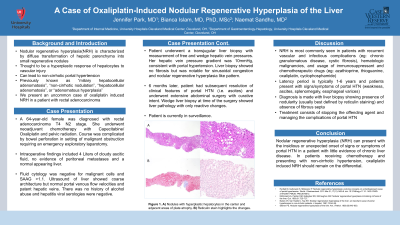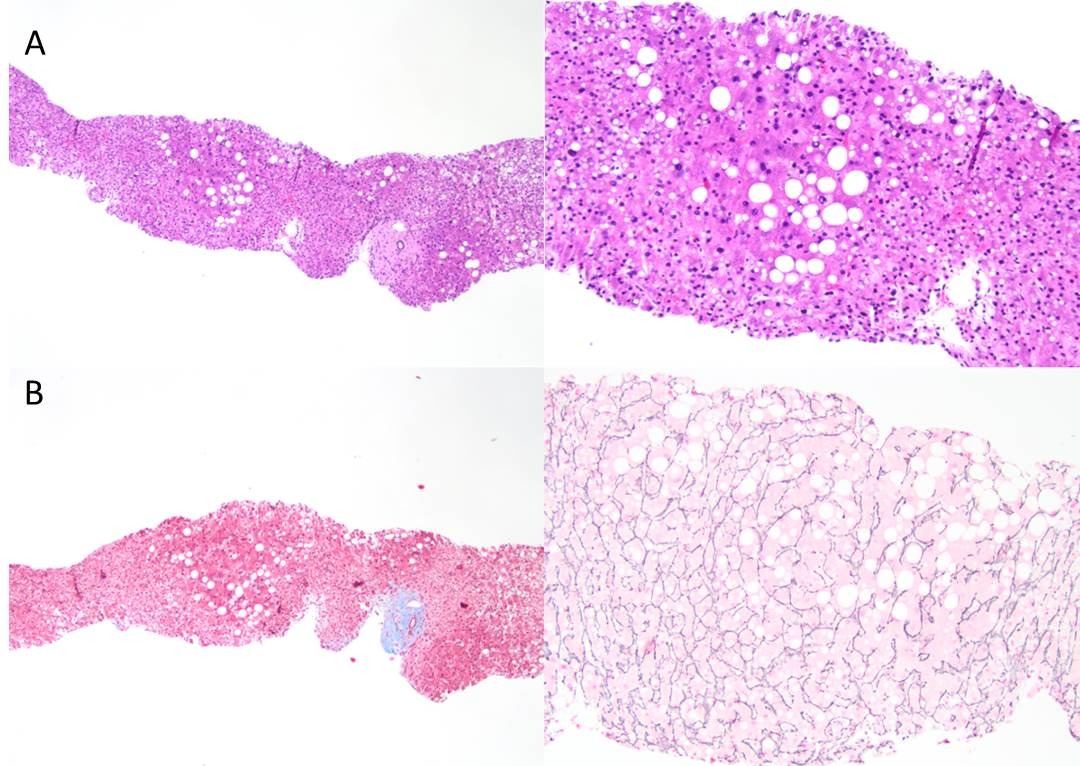Back


Poster Session B - Monday Morning
Category: Liver
B0609 - A Case of Oxaliplatin-Induced Nodular Regenerative Hyperplasia of the Liver
Monday, October 24, 2022
10:00 AM – 12:00 PM ET
Location: Crown Ballroom

Has Audio

Jennifer Park, MD
University Hospitals Cleveland Medical Center
Cleveland, OH
Presenting Author(s)
Jennifer Park, MD1, Bianca N. Islam, MD, PhD2, Naemat Sandhu, 3
1University Hospitals Cleveland Medical Center, Cleveland, OH; 2UHCMC, Cleveland, OH; 3University Hospital, Cleveland, OH
Introduction: Nodular regenerative hyperplasia(NRH) is a form of noncirrhotic portal HTN most commonly seen in patients with multiple, recurrent vascular and infectious complications. We present an uncommon case of oxaliplatin induced NRH in a patient with rectal adenocarcinoma.
Case Description/Methods: A 64-year-old female was diagnosed with rectal adenocarcinoma T4 N2 stage. She underwent neoadjuvant chemotherapy with Capecitabine/Oxaliplatin and pelvic radiation. Her course was complicated by acute bowel obstruction requiring placement of a colonic stent which became dislodged, leading to acute bowel perforation and an emergency exploratory laparotomy. Intraoperative findings included 4 Liters of cloudy ascitic fluid, no evidence of peritoneal metastases and a normal appearing liver. She was treated with IV antibiotics, diversion ileostomy, and aggressive fluid replacement. On closer review of imaging, there was evidence of ascites 2 months prior. Fluid cytology was negative for malignant cells and SAAG was greater than 1.1 but felt to be unreliable given recent aggressive albumin therapy. Ultrasound of liver showed coarse architecture but normal portal venous flow velocities and patent hepatic veins. There was no history of alcohol abuse and hepatitis viral serologies were negative.
A definitive major abdominal surgery for her rectal cancer with possible need for pelvic exenteration was being considered by the surgical team. Ascertaining the presence of portal hypertension, establishing underlying liver pathology if present, and determining etiology of ascites were all felt to be vital. Patient underwent a transjugular liver biopsy with measurement of free and wedge hepatic vein pressures. Her hepatic vein pressure gradient was 10mmHg, consistent with portal hypertension. Liver biopsy showed no fibrosis but was notable for sinusoidal congestion and nodular regenerative hyperplasia like pattern. 6 months later, patient underwent extensive abdominal surgery with curative intent. Wedge liver biopsy at time of the surgery showed liver pathology with only reactive changes. She is not currently on any chemotherapy and is in surveillance.
Discussion: Nodular regenerative hyperplasia(NRH) can present with the insidious or unexpected onset of signs or symptoms of portal HTN (weakness, ascites, esophageal varices) in a patient with little evidence of chronic liver disease. In patients receiving chemotherapy and presenting with noncirrhotic hypertension, oxaliplatin induced NRH should remain on the differential.

Disclosures:
Jennifer Park, MD1, Bianca N. Islam, MD, PhD2, Naemat Sandhu, 3. B0609 - A Case of Oxaliplatin-Induced Nodular Regenerative Hyperplasia of the Liver, ACG 2022 Annual Scientific Meeting Abstracts. Charlotte, NC: American College of Gastroenterology.
1University Hospitals Cleveland Medical Center, Cleveland, OH; 2UHCMC, Cleveland, OH; 3University Hospital, Cleveland, OH
Introduction: Nodular regenerative hyperplasia(NRH) is a form of noncirrhotic portal HTN most commonly seen in patients with multiple, recurrent vascular and infectious complications. We present an uncommon case of oxaliplatin induced NRH in a patient with rectal adenocarcinoma.
Case Description/Methods: A 64-year-old female was diagnosed with rectal adenocarcinoma T4 N2 stage. She underwent neoadjuvant chemotherapy with Capecitabine/Oxaliplatin and pelvic radiation. Her course was complicated by acute bowel obstruction requiring placement of a colonic stent which became dislodged, leading to acute bowel perforation and an emergency exploratory laparotomy. Intraoperative findings included 4 Liters of cloudy ascitic fluid, no evidence of peritoneal metastases and a normal appearing liver. She was treated with IV antibiotics, diversion ileostomy, and aggressive fluid replacement. On closer review of imaging, there was evidence of ascites 2 months prior. Fluid cytology was negative for malignant cells and SAAG was greater than 1.1 but felt to be unreliable given recent aggressive albumin therapy. Ultrasound of liver showed coarse architecture but normal portal venous flow velocities and patent hepatic veins. There was no history of alcohol abuse and hepatitis viral serologies were negative.
A definitive major abdominal surgery for her rectal cancer with possible need for pelvic exenteration was being considered by the surgical team. Ascertaining the presence of portal hypertension, establishing underlying liver pathology if present, and determining etiology of ascites were all felt to be vital. Patient underwent a transjugular liver biopsy with measurement of free and wedge hepatic vein pressures. Her hepatic vein pressure gradient was 10mmHg, consistent with portal hypertension. Liver biopsy showed no fibrosis but was notable for sinusoidal congestion and nodular regenerative hyperplasia like pattern. 6 months later, patient underwent extensive abdominal surgery with curative intent. Wedge liver biopsy at time of the surgery showed liver pathology with only reactive changes. She is not currently on any chemotherapy and is in surveillance.
Discussion: Nodular regenerative hyperplasia(NRH) can present with the insidious or unexpected onset of signs or symptoms of portal HTN (weakness, ascites, esophageal varices) in a patient with little evidence of chronic liver disease. In patients receiving chemotherapy and presenting with noncirrhotic hypertension, oxaliplatin induced NRH should remain on the differential.

Figure: A) Nodules with hyperplastic hepatocytes in the center and adjacent areas of plate atrophy. B) Reticulin stain highlights the changes.
Disclosures:
Jennifer Park indicated no relevant financial relationships.
Bianca Islam indicated no relevant financial relationships.
Naemat Sandhu indicated no relevant financial relationships.
Jennifer Park, MD1, Bianca N. Islam, MD, PhD2, Naemat Sandhu, 3. B0609 - A Case of Oxaliplatin-Induced Nodular Regenerative Hyperplasia of the Liver, ACG 2022 Annual Scientific Meeting Abstracts. Charlotte, NC: American College of Gastroenterology.
